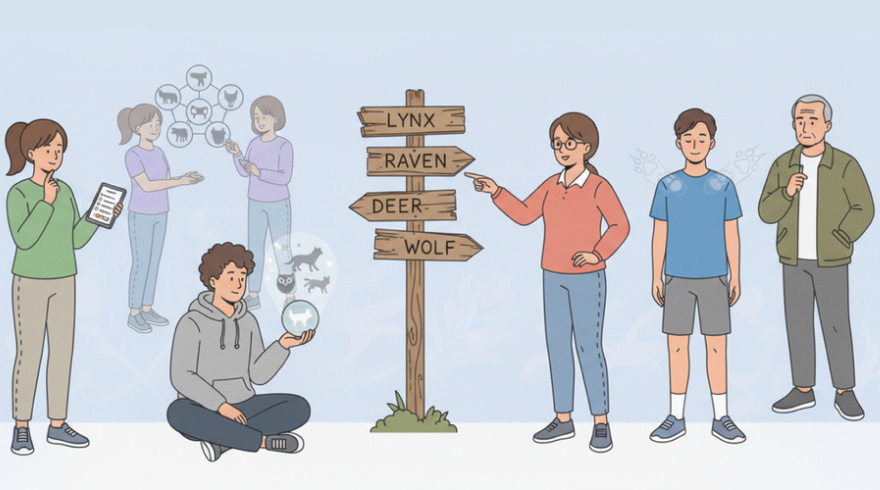Discovering Your Therian Self: A Comprehensive Guide

Understanding Therianthropy and the Journey of Identification
Therianthropy describes an enduring, embodied identification with a non-human animal, not as fantasy or costume but as a deep-rooted facet of self. Many people arrive here after years of subtle signals: vivid body memories, instinctive postures, or an inexplicable pull toward specific habitats and behavioral rhythms. Rather than a trend or role-play, this path is contemplative, experiential, and often intensely private. The goal is not pretending, but recognizing recurrent patterns that reveal how you relate to the world, your senses, and your social environment. As with any identity work, patience and sincerity matter more than speed. Careful attention to your physical cues and emotional landscapes can open doors that quick labels might miss.
In the early stages, it helps to separate external aesthetics from inner resonance, because traits that look impressive aren’t always a match for your nervous system or temperament. For many seekers, the question of what therian animal am I surfaces after months of noticing instinctual patterns that feel older than habit, and that observation becomes a compass you return to repeatedly. Over time, you may recognize how certain gaits, sounds, or terrains feel like home, even if you’ve never visited them. This is less about borrowing imagery and more about decoding consistent signals that arise in stillness, during movement, or in the liminal space of dreams. The inquiry gets richer as you track it, write it down, and observe the seasons of your own embodiment.
- Notice sensations that recur during stress, joy, and rest.
- Distinguish admiration from identification by asking how your body responds.
- Record dreams and daydreams that reveal posture, pack dynamics, or territory.
- Let the process take time, because clarity grows through repetition.
Why Identifying Your Animal Can Be Transformative
Beyond curiosity, this exploration can sharpen self-knowledge and emotional regulation. When you learn the rhythms that feel authentic, everyday choices become simpler: the social environments that fit, the activities that soothe, and the boundaries that protect. Identification can offer language for sensations that once felt random, reducing frustration while increasing compassion for your own nervous system. With that clarity comes grounded confidence, you can advocate for needs without apology and design routines that align with your instinctive pace. The payoff often appears in subtle ways: improved sleep, steadier moods, and a sense of belonging in your own skin.
Benefits also show up in relationships, because understanding your baseline behaviors helps you communicate expectations cleanly and kindly. As self-knowledge deepens, the quieter inquiry of what is my therian animal often replaces vague curiosity with a grounded, testable hypothesis that reduces second-guessing. This shift eases social friction and invites healthier community ties, particularly in spaces where nuance is respected. Over time, many people report feeling less scattered and more integrated, with a daily cadence that honors their instincts while remaining flexible. When you view your patterns with curiosity rather than judgment, the whole process becomes gentler and more sustainable.
- Greater emotional vocabulary for somatic states and shifts.
- Strategic routines that fit your energy peaks and troughs.
- Healthier boundaries and less burnout from misaligned environments.
- More meaningful, mutually respectful connections.
Approaches to Exploration: Observation, Practice, and Reflection
Methodical investigation keeps this journey honest. Start by journaling sensory details: your posture under pressure, your preferred pace, and the settings that restore you. Meditation and mindful movement reveal how your body wants to organize itself when you stop forcing it. Dreamwork and daylight reveries can surface symbolic material, which you later test against real-world behavior. Art, music, and scent are also powerful tools, because they bypass overthinking and invite instinctual responses you can document. The key is iteration, observe, experiment, record, and refine your working model.
Used thoughtfully, a reflective therian animal test can function like a mirror that prompts nuanced memories rather than dictating outcomes, and your notes afterward will matter more than the score itself. Cross-validate insights by comparing them to field guides, ethology snippets, and first-hand nature observation where safe and ethical. You’re not trying to cosplay behavior; you’re translating how your nervous system already behaves into a species-aligned vocabulary that makes sense. To support your practice, the following quick-reference table summarizes common approaches, the kind of data they surface, and how to apply them over time.
| Approach | What It Reveals | Helpful Tools | Time Investment |
|---|---|---|---|
| Somatic journaling | Posture, gait, stress responses | Notebook, body scan prompts | 10–15 min daily |
| Mindful movement | Natural cadence and orientation | Breath timers, soft floor space | 20–30 min, 3x weekly |
| Dreamwork | Symbolic motifs, territories | Bedside notes, voice memos | 5 min upon waking |
| Nature immersion | Sensory triggers and comfort zones | Field journal, weather-appropriate wear | 1–2 hrs weekly |
| Creative mapping | Emotional tone and archetypes | Collage, playlists, scent samples | Flexible, project-based |
- Rotate modalities so you capture data across contexts.
- Annotate results with date, mood, and environment for patterns.
- Revisit notes monthly to refine hypotheses.
Interpreting Signals: From Instinct to Species-Level Clarity
Gathering data is only half the work; interpretation ties the threads together. Look for constellations of evidence rather than isolated moments, a recurring fondness for dusk, a drive to patrol, or a comfort with solitude may point in a specific direction. Compare your lived patterns with ethological traits, noting similarities and disconfirming details. Dissonance is helpful because it narrows the field and prevents wishful thinking. When you find a potential fit, test it by observing how your body responds to species media: calls, movement footage, and habitat recordings. Authentic alignment typically feels like relief rather than excitement alone.
If your observations conflict, slow down and prioritize the body over narratives. When you feel torn between two archetypes, a structured therian quiz what animal am i may highlight gaps in your journaling that deserve follow-up work, but you should still treat it as a prompt, not a verdict. Keep refining by listing core traits and ranking their intensity across situations such as work, rest, and social time. The goal is a layered profile that withstands time and context changes. Over weeks and months, the outliers tend to fade while the through-lines remain, offering a durable foundation for identity claims that feel both intimate and credible.
- Seek disconfirming evidence to avoid confirmation bias.
- Favor stable patterns over mood-dependent spikes.
- Let relief and coherence be stronger signals than novelty.
Avoiding Pitfalls and Navigating Myths
Because this topic is nuanced, misinformation can derail your progress. One common trap is equating aesthetic attraction with identification; admiring a powerful predator doesn’t mean your nervous system runs on that template. Another is rushing for a label to gain social belonging; speed often invites later doubts. Beware of content that promises instant answers, as real clarity forms through cycles of observation and gentle testing. Ethical considerations matter, too: avoid replicating dangerous behaviors or disturbing wildlife in search of validation. Authenticity thrives within safety, consent, and respect for living ecosystems.
Community spaces can be tremendously supportive when they encourage discernment over dogma. If you enjoy metrics, a comparative therian animal type test can offer gentle signals without replacing your lived experience, and debriefing with a trusted peer may reveal blind spots you missed. Prioritize sources that reference ethology, sensory processing, and embodied practice rather than pure symbolism. Finally, remember that identities may evolve; staying open to refinement prevents you from getting stuck defending an early draft of yourself. Patience and humility keep the exploration honest and humane.
- Differentiate admiration, aspiration, and identification.
- Use tools as guides, not authorities.
- Protect your safety and the well-being of animals and habitats.
A Practical Roadmap: Seven Steps to Confident Alignment
Structure can transform a vague search into a grounded, repeatable practice. Begin with a baseline week of logging somatic states, daily energy cycles, and social preferences. In week two, add movement experiments that let your body show its default cadence without choreography. Week three invites nature immersion, even if it’s a city park, pay attention to which micro-environments regulate you best. By week four, synthesize your notes into candidate profiles and test them gently through media and sensory prompts. The remaining weeks focus on iteration and integration.
As you expand your toolkit, stay curious and keep your notes precise. Near the midpoint of your exploration, a curated what is your therian animal quiz can provide a snapshot you revisit after deeper practice, and your reflections afterward will be the real treasure. By the end of the cycle, aim to articulate a concise species statement supported by at least three stable behavioral markers. Then test it across new contexts, travel, season changes, and varying social demands, to confirm resilience. This rhythm balances intuition with method, yielding clarity that feels lived-in rather than borrowed.
- Week 1: Somatic log and mood map.
- Week 2: Movement and cadence trials.
- Week 3: Habitat comfort exploration.
- Week 4: Candidate species synthesis.
- Weeks 5–7: Iteration, integration, and validation.
Tools, Rituals, and Creative Practices That Deepen Insight
Rituals provide continuity, helping you return to the inquiry when life gets noisy. A short dawn or dusk routine can center your senses at the times many animals are most active. Soundscapes, tactile objects, and scent vials invite honest, immediate responses you can map without words. Artistic practices, collage, improvisational movement, or field sketching, turn data into form, revealing patterns you might overlook in plain text. Treat each creative session as a laboratory where curiosity outruns certainty, and make space to rest so integrations can settle.
Sharing carefully with peers can widen your perspective without diluting your voice. For community workshops, a collaborative your therian animal quiz becomes a conversation starter rather than an oracle, and the group discussion afterward often yields the sharpest insights. Rotate tools to avoid overfitting a single method, and archive everything in a living document you revisit monthly. Over time, you’ll recognize a cadence of evidence that points in one direction more consistently than the rest, and that’s where your energy should go next.
- Create sensory kits for different habitats or moods.
- Use playlists to probe dusk, night, or open-field states.
- Schedule reflection days to re-read and re-annotate your logs.
Community, Ethics, and Sustainable Next Steps
A supportive community can validate experiences while keeping standards high. Look for spaces that value safety, informed consent, and the ability to say “I don’t know yet.” When sharing, disclose what is tentative and what is stable so others can offer relevant feedback. Ethics should extend to how you engage with real animals and ecosystems; admiration never justifies disruption or harm. Treat habitat visits as opportunities to learn attention, not to mimic behavior that endangers you or wildlife. Integrity builds trust, within yourself and with others.
As your confidence grows, it’s helpful to maintain a beginner’s mind to prevent stagnation. At any stage, a well-designed therian animal quiz works best as a compass you check occasionally while you keep walking, and letting results challenge you without overruling your diary creates balanced momentum. Commit to periodic audits of your practice, pruning tools that no longer help and adding those that do. The most durable outcomes arise when curiosity, care, and accountability move together, turning identity work into a lifelong, life-giving craft.
- Choose communities that prize nuance and informed care.
- Treat the natural world as teacher, not stage.
- Recalibrate tools and routines as your life context shifts.
FAQ: Common Questions About Therian Identification
How long does it usually take to identify a species alignment?
Timelines vary widely, but many people see clearer patterns after a few months of regular journaling and movement practice. Durable confidence typically emerges when your observations remain consistent across seasons and social contexts rather than relying on a single breakthrough moment.
What’s the difference between admiration and identification?
Admiration is aesthetic or conceptual; identification is somatic and behavioral. If the traits show up in your posture, pacing, stress responses, and preferred environments, especially under pressure, you’re looking at identification rather than simple appreciation.
Can I be unsure or mixed between species?
Ambiguity is common early on. Use structured notes and disconfirming tests to separate overlapping traits. Over time, the through-lines persist while outliers fade, and that gradual consolidation often clarifies whether you’re looking at a single species or a stable blend.
Do I need community feedback to be certain?
Outside perspectives can reveal blind spots, but your lived, repeated evidence is primary. Share selectively with thoughtful peers who respect nuance, and weigh feedback against long-term patterns in your own records rather than chasing outside validation.
How should I handle shifts or changing experiences?
Track frequency, triggers, and intensity over weeks instead of judging one-off events. Shifts that integrate smoothly with daily life and align with your broader profile usually indicate meaningful data, while sporadic spikes may reflect stress or situational influences.
Latest News



